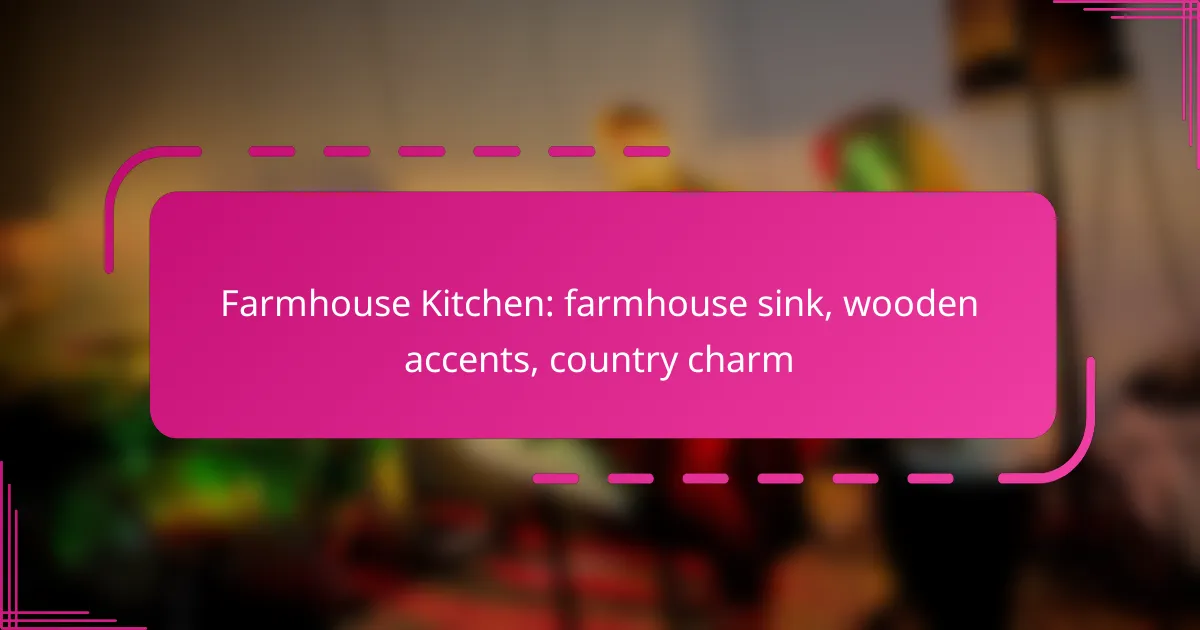A farmhouse kitchen embodies country charm through its inviting design and rustic elements. Central to this aesthetic is the farmhouse sink, which combines functionality with a timeless appeal. Complementing this feature, wooden accents in natural materials like oak or pine enhance the warmth and character of the space, creating a cozy atmosphere perfect for family gatherings.

How to choose a farmhouse sink for your kitchen?
Choosing a farmhouse sink involves considering materials, size, and style compatibility to ensure it fits your kitchen’s design and functionality. Focus on durability, aesthetics, and how the sink will integrate with your existing decor.
Material options: stainless steel, fireclay, cast iron
Farmhouse sinks come in various materials, each offering distinct advantages. Stainless steel is durable and easy to clean, making it a popular choice for modern kitchens. Fireclay provides a classic look with high resistance to scratches and stains, while cast iron offers exceptional durability and a wide range of colors.
When selecting a material, consider your cooking habits and maintenance preferences. For example, if you frequently use heavy pots, cast iron may be ideal, but it requires careful handling to avoid chipping. Fireclay, while beautiful, can be more susceptible to cracking if not installed correctly.
Size considerations: single vs. double basin
Deciding between a single or double basin farmhouse sink is crucial for functionality. A single basin offers ample space for washing large pots and pans, while a double basin allows for multitasking, such as washing dishes on one side and rinsing vegetables on the other.
Measure your available counter space before making a decision. Single basin sinks typically range from 30 to 36 inches in width, while double basins can be slightly wider. Ensure your choice complements your kitchen layout and meets your daily needs.
Style compatibility: apron front vs. undermount
Farmhouse sinks can be installed as apron front or undermount styles, each providing different aesthetic appeals. An apron front sink protrudes from the cabinetry, creating a striking focal point, while an undermount sink offers a sleek, seamless look that integrates well with countertops.
Consider your kitchen’s overall design when choosing a style. An apron front sink pairs beautifully with rustic or traditional decor, while an undermount sink is often favored in contemporary settings. Ensure that your cabinetry can support the weight and installation requirements of your chosen style.

What are the best wooden accents for a farmhouse kitchen?
The best wooden accents for a farmhouse kitchen include natural materials that enhance the rustic charm and warmth of the space. Popular choices often feature oak, pine, or reclaimed wood, which can be used in various accent pieces like shelves and furniture.
Popular woods: oak, pine, reclaimed wood
Oak is a durable hardwood known for its strength and beautiful grain, making it a favorite for kitchen cabinets and countertops. Pine, a softer wood, offers a lighter color and is often used for beams and open shelving, providing a more casual feel. Reclaimed wood adds character and sustainability, as it repurposes old materials into new designs.
When selecting wood, consider the overall style of your kitchen. Oak suits traditional designs, while pine complements a more relaxed, country aesthetic. Reclaimed wood can be a striking focal point in both modern and rustic settings.
Accent pieces: shelves, beams, furniture
Wooden shelves can serve both functional and decorative purposes, showcasing dishes or rustic decor. Open shelving made from oak or pine can create an airy feel while maintaining accessibility. Wooden beams, whether structural or decorative, can enhance the farmhouse look by adding visual interest and depth to the ceiling.
Furniture pieces like farmhouse tables or wooden stools should match the chosen wood type to create a cohesive look. Mixing different woods can work, but aim for a harmonious color palette to avoid visual clutter.
Finish options: stained vs. painted
Choosing between stained and painted finishes depends on the desired look and maintenance level. Stains enhance the natural beauty of the wood, highlighting its grain while providing a protective layer. This option is ideal for those who want to keep the rustic charm intact.
Painted finishes offer a more uniform appearance and can introduce color into the kitchen. However, painted surfaces may require more upkeep to prevent chipping. Consider your lifestyle and the kitchen’s overall design when deciding on finishes.

How to achieve country charm in your kitchen design?
To achieve country charm in your kitchen design, focus on incorporating rustic elements, warm colors, and inviting textures. Key features include a farmhouse sink, wooden accents, and decorative touches that evoke a cozy, countryside feel.
Color palettes: soft pastels, earthy tones
Selecting the right color palette is essential for creating a country charm in your kitchen. Soft pastels like light blues, pale yellows, and mint greens can evoke a serene atmosphere, while earthy tones such as browns, greens, and warm grays add warmth and depth.
Consider using these colors on walls, cabinetry, and accents. A combination of soft pastels for larger surfaces and earthy tones for smaller details can create a balanced, inviting space.
Decorative elements: vintage signs, ceramic dishes
Incorporate decorative elements that reflect a rustic aesthetic, such as vintage signs and ceramic dishes. Vintage signs can add character and a sense of history, while ceramic dishes in soft colors or floral patterns enhance the country feel.
Display these items on open shelves or as part of a gallery wall. Mixing functional pieces with decorative ones creates a lived-in look that is both practical and charming.
Lighting choices: pendant lights, lanterns
Lighting plays a crucial role in establishing the ambiance of a country-style kitchen. Pendant lights with a vintage finish can serve as focal points above islands or dining areas, while lantern-style fixtures add a rustic touch.
Choose warm-toned bulbs to enhance the inviting atmosphere. Layering different light sources, such as under-cabinet lighting and wall sconces, can create a cozy environment perfect for family gatherings and cooking.

What are the costs associated with a farmhouse kitchen renovation?
The costs of renovating a farmhouse kitchen can vary widely based on materials, labor, and design choices. Homeowners should expect to invest several thousand dollars, with total expenses often ranging from low tens of thousands to over fifty thousand USD, depending on the scope of the project.
Average costs for sinks and fixtures
Farmhouse sinks and fixtures typically range from around 300 to 2,500 USD. The price largely depends on the material, such as stainless steel, fireclay, or cast iron, with high-end options offering unique designs and durability. Additionally, consider the cost of faucets, which can add another 100 to 1,500 USD to your budget.
Budgeting for cabinetry and countertops
Cabinetry and countertops are significant expenses in a farmhouse kitchen renovation, often costing between 5,000 and 20,000 USD. Solid wood cabinets, which align well with the farmhouse aesthetic, can be more expensive but offer longevity and charm. For countertops, materials like granite or quartz can range from 50 to 150 USD per square foot, depending on the quality and finish.
Labor costs in urban vs. rural areas
Labor costs for kitchen renovations can differ significantly between urban and rural areas. In urban settings, hourly rates for skilled labor may range from 50 to 150 USD, while rural areas might see rates between 30 and 80 USD. This discrepancy can impact the overall budget, so it’s wise to obtain multiple quotes and consider the location when planning your renovation.

What are the trends in farmhouse kitchen designs for 2024?
In 2024, farmhouse kitchen designs emphasize a blend of traditional charm and modern functionality. Key trends include the integration of smart technology, the use of eco-friendly materials, and a harmonious mix of rustic and contemporary styles.
Incorporating smart technology
Smart technology is becoming increasingly popular in farmhouse kitchens, enhancing convenience and efficiency. Features such as smart refrigerators, voice-activated faucets, and automated lighting systems allow for seamless integration into the rustic aesthetic.
When choosing smart devices, consider compatibility with existing appliances and the ease of use. Look for options that blend well with wooden accents and traditional fixtures to maintain the farmhouse charm.
Eco-friendly materials and practices
Eco-friendly materials are a significant trend in farmhouse kitchens, reflecting a growing awareness of sustainability. Reclaimed wood, bamboo, and recycled metals are popular choices that add character while minimizing environmental impact.
Incorporating energy-efficient appliances and water-saving fixtures can further enhance sustainability. Opt for low-VOC paints and finishes to ensure a healthier indoor environment, aligning with the farmhouse ethos of natural living.
Mixing modern and rustic styles
The trend of mixing modern and rustic styles allows homeowners to create unique and personalized spaces. Combining sleek, contemporary elements like stainless steel appliances with traditional wooden cabinetry can create a balanced look that feels both fresh and inviting.
To achieve this blend, focus on color palettes that complement both styles, such as neutral tones with pops of color. Incorporate modern lighting fixtures alongside rustic decor to enhance the overall aesthetic while maintaining the warmth of a farmhouse kitchen.

What are the key features of a farmhouse kitchen?
A farmhouse kitchen is characterized by its rustic charm, practical layout, and welcoming atmosphere. Key features include a farmhouse sink, wooden accents, and an open design that promotes a sense of community and functionality.
Open layout and spacious design
The open layout of a farmhouse kitchen encourages interaction and movement, making it ideal for family gatherings and entertaining. This design typically features a large central island that serves as both a workspace and a casual dining area.
To achieve a spacious feel, consider using light colors and natural materials. High ceilings and large windows can enhance the openness, allowing for ample natural light and a connection to the outdoors.
Functional storage solutions
Effective storage is crucial in a farmhouse kitchen to maintain its charm while ensuring practicality. Open shelving, cabinets with glass doors, and built-in pantry spaces can provide easy access to kitchen essentials while displaying decorative items.
Incorporate multi-functional furniture, such as benches with hidden storage or islands with drawers, to maximize space. Aim for a balance between decorative and functional storage to keep the kitchen organized without sacrificing style.
